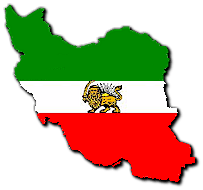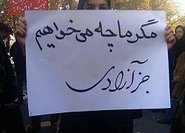A report based on declassified documents suggests that the Nixon and Ford administrations, angry with the shah for his support for raising oil prices, worked to curb his ambitions.
BEIRUT -- A new report based on previously classified documents suggests that the Nixon and Ford administrations created conditions that helped destabilize Iran in the late 1970s and contributed to the country's Islamic Revolution. A trove of transcripts, memos and other correspondence show sharp differences over rising oil prices developing between the Republican administrations and Mohammed Reza Shah Pahlavi in the mid-1970s, says a report to be published today in the fall issue of Middle East Journal, an academic journal published by the Washington-based Middle East Institute, a think tank. The report, after two years of research by scholar Andrew Scott Cooper, zeros in on the role of White House policymakers -- including Donald H. Rumsfeld, then a top aide to President Ford -- hoping to roll back oil prices and curb the shah's ambitions, despite warnings by then-Secretary of State Henry Kissinger that such a move might precipitate the rise of a "radical regime" in Iran. "The shah is a tough, mean guy. But he is our real friend," Kissinger warned Ford, who was considering options to press the monarch into lowering oil prices, in an August 1974 conversation cited by the report. "We can't tackle him without breaking him."Analysts and historians often contend that President Carter, a Democrat, fumbled Iran, allowing the country to eventually become one of the chief U.S. opponents in the region. But the report suggests that his Republican predecessors not only contributed to the shah's fall but also were inching toward a realignment with Saudi Arabia as the key U.S. ally in the Persian Gulf. The examination of pre- revolutionary Iran has special relevance today. Cooper said Iran's economic situation just before the revolution resembled its current state, this time with big-spending President Mahmoud Ahmadinejad banking on high oil prices to sustain his power. "Ahmadinejad's fiscal recklessness is eerily reminiscent of the shah's, with Iran's inflation rate running at approximately 30% and Iran's current deficit approximately $12 billion -- not to mention widespread underemployment and unemployment," Cooper said in an e-mail. The report, based mostly on documents stored at the Gerald R. Ford Presidential Library in Ann Arbor, Mich., opens a window on an unruly period more than 30 years ago that precipitated Iran's 1979 Islamic Revolution, which established a template for religiously inspired Muslim movements throughout the Middle East. As high oil prices in the early 1970s began strangling the U.S. economy, Washington began to sour on Iran, the documents suggest. After an oil embargo over American support of Israel ended in March 1974, U.S. officials considered the shah the principal culprit in keeping oil prices from falling and wanted him to put on the brakes. At one point, Rumsfeld, who later served as the current President Bush's Defense secretary, warned Iran's chief arms procurement official that Tehran was losing friends in Washington. "Don't try to get around me," he reportedly told Gen. Hassan Toufanian, in an encounter described by the Washington Post three decades ago and cited in the report. "Remember, Kissinger and I have to approve all [arms] exports."Chief among those advocating pressure on Iran was William Simon, who served as Treasury secretary and energy czar under the Nixon and Ford administrations. He blamed the shah for high oil prices and wanted the U.S. to use weapons sales to Tehran as leverage. "He is the ringleader on oil prices, together with Venezuela," Simon told President Nixon in July 1974, referring to the Iranian ruler. "Is it possible to put pressure on the shah?"Over the years, Kissinger advocated a friendlier line on Iran and the shah, who had been brought back to power by a U.S.-engineered coup in 1953. The report suggests that Kissinger had special insights into the country's instability. At the time, university campuses in Iran were in turmoil, and guerrillas were attacking U.S. facilities and assassinating key officials. Even in 1974, a CIA analysis sounded the alarm, saying the shah's ambitious buildup of the country was causing economic polarization and cultural clashes that were roiling Iran.By late 1976 the shah was in deep financial trouble, facing a huge cash crunch. He wanted the Organization of the Petroleum Exporting Countries oil cartel, or OPEC, to raise oil prices by 25%, a move the U.S. opposed."There is unanimity among my advisors that the world economy health is not good," Ford told Iranian Ambassador Ardeshir Zahedi in December 1976, according to the archives. "Any increase in the price of oil would have a serious impact on the world financial structure."But U.S. officials, especially Simon, had been working with Saudi officials behind the shah's back to seek help on oil prices in exchange for political and military support for the Arab kingdom. The Saudis stunned OPEC by announcing at a December summit in Doha, Qatar, that they would boost production to 11.6 million barrels a day from 8.6 million barrels, driving down prices. "We should get credit for what happened at OPEC," Kissinger told Ford. "I have said all along the Saudis were the key. . . . Our great diplomacy is what did it."But it would prove to be a Pyrrhic victory in terms of one American ally. Iran was cash-strapped, having spent much of its reserves on American weapons and the shah's Great Civilization programs, which spurred inflation by flooding the country with money.The shah was broke. Declining oil revenue amid continued inflation forced him to abandon ambitious plans to modernize his country. "The collapse of the Doha summit, and the Saudi decision to undercut the price of crude and boost its output to try to flood the market, rushed the Iranian economy to the precipice," Cooper writes in his report. The shah's government, shaken by the loss of oil revenue, imposed a harsh austerity budget that threw thousands out of work, collapsed investor confidence and panicked middle-class Iranians. Economic chaos and unemployment quickly spread. Within a year of the Doha summit, the first mass demonstrations that grew into revolution broke out on the streets of the Iranian capital.


























 اخبار مربوط به زندانیان سیاسی و نقض حقوق بشر
اخبار مربوط به زندانیان سیاسی و نقض حقوق بشر

















 Tulips in Holland
Tulips in Holland












No comments:
Post a Comment